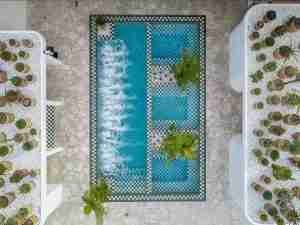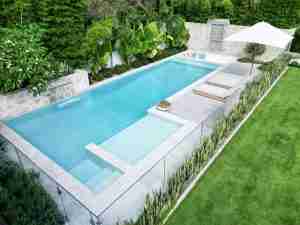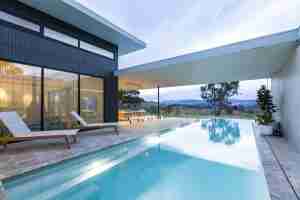When it comes to creating the perfect concrete pool surrounds, there are several important factors to consider. Understanding the basics of concrete pool surrounds is essential in order to make informed decisions and create a beautiful and functional space around your pool.
Understanding the Basics of Concrete Pool Surrounds
A concrete pool surround refers to the area immediately surrounding your pool. It is an important element of pool design as it not only enhances the overall aesthetic appeal but also serves practical purposes such as providing a safe and slip-resistant surface.
When it comes to creating the perfect pool area, the pool surround plays a crucial role. It is not just a mere border but a carefully constructed area made of concrete that serves as a transition zone between your pool and the surrounding landscape or decking. The choice of material for your pool surround is essential, and concrete is a popular choice for many reasons.
What is a Concrete Pool Surround?
A concrete pool surround is a carefully constructed area made of concrete that borders your pool. It serves as a transition zone between your pool and the surrounding landscape or decking. Concrete is a popular choice for pool surrounds due to its durability, versatility, and aesthetic appeal.
Concrete pool surrounds are meticulously designed and built to complement the overall pool design and create a seamless transition from the pool to the surrounding area. Whether you have a modern, minimalist pool design or a more traditional one, a concrete pool surround can be customized to match your style and preferences.
Benefits of Concrete for Pool Surrounds
There are several benefits to using concrete for your pool surround. Firstly, concrete is a highly durable material that can withstand the harsh Australian climate and resist wear and tear. This means that your pool surround will remain in excellent condition for years to come, without the need for frequent repairs or replacements.
Another advantage of concrete pool surrounds is their versatility. Concrete can be molded into various shapes and sizes, allowing you to create a pool surround that perfectly fits your pool’s dimensions and design. Whether you prefer a simple rectangular shape or a more intricate design with curves and angles, concrete can be customized to meet your requirements.
In addition to durability and versatility, concrete pool surrounds offer aesthetic appeal. With a wide range of colors, finishes, and textures available, you can create a pool surround that complements your overall outdoor design and enhances the visual appeal of your pool area. From natural earth tones to vibrant hues, the possibilities are endless when it comes to customizing your concrete pool surround.
Furthermore, concrete can be textured or stamped to provide a safe and non-slip surface, ensuring the safety of pool users. This is especially important in areas where the pool surround is exposed to water, as wet surfaces can become slippery and pose a risk of accidents. By adding texture or stamping patterns to the concrete, you can create a surface that not only looks visually appealing but also provides traction and reduces the risk of slips and falls.
In conclusion, a concrete pool surround is more than just a border around your pool. It is a carefully designed and constructed area that enhances the overall aesthetic appeal of your pool area while providing practical benefits such as durability, customization options, and safety. Whether you are building a new pool or renovating an existing one, consider the advantages of a concrete pool surround and create a stunning outdoor space that you can enjoy for years to come.
Choosing the Right Concrete for Your Pool Surround
When selecting the concrete for your pool surround, there are certain factors to consider to ensure optimal performance and longevity.
Factors to Consider When Selecting Concrete
One important factor to consider is the climate in which you live. Australia experiences a wide range of climates, from hot and dry conditions to humid areas. It is important to choose a concrete mix that can withstand the specific climatic conditions of your region.
Another factor to consider is the level of maintenance you are willing to commit to. Some types of concrete require more frequent maintenance and care, while others are more low-maintenance. Consider your lifestyle and preferences when choosing the concrete for your pool surround.
Types of Concrete Suitable for Pool Surrounds
There are several types of concrete that are suitable for pool surrounds. These include exposed aggregate concrete, which has a textured surface that provides additional grip and visual interest, and stamped concrete, which can mimic the look of various materials such as stone or tile. In addition, colored concrete can be used to add a pop of color to your pool surround, creating a vibrant and unique look.
Designing Your Concrete Pool Surround
Once you have selected the right type of concrete for your pool surround, it is time to consider the design aspects. There are various design trends and customization options available to create a pool surround that perfectly suits your style and preferences.
Popular Design Trends for Concrete Pool Surrounds
In Australia, popular design trends for concrete pool surrounds include using natural materials such as timber or stone to create a seamless transition between the pool and the surrounding landscape. Another trend is incorporating geometric patterns or decorative borders into the concrete design to add visual interest and enhance the overall aesthetic appeal.
Customizing Your Pool Surround Design
Customization options for your concrete pool surround are virtually limitless. You can choose from a wide range of colors, finishes, and textures to create a unique look that complements your pool and outdoor living space. Additionally, you can consider incorporating features such as built-in seating areas, waterfalls, or outdoor kitchens into your pool surround design to further enhance its functionality.
The Process of Installing a Concrete Pool Surround
Installing a concrete pool surround requires careful planning and execution. Proper preparation and following the correct installation steps are crucial to ensure a high-quality and long-lasting result.
Preparing for Installation
Prior to the installation, the area where the concrete pool surround will be placed needs to be properly prepared. This includes removing any existing materials or vegetation, leveling the ground, and creating a stable base for the concrete.
It is also important to consider factors such as drainage to prevent water pooling around the pool surround. Proper drainage can help prevent damage to the concrete and ensure the safety of pool users.
Steps in the Installation Process
Once the preparation is complete, the installation process can begin. This typically involves pouring and shaping the concrete, smoothing the surface, and adding any desired decorative elements or finishes.
Proper curing and sealing of the concrete are essential to ensure its longevity and resistance to the elements. It is important to follow the manufacturer’s instructions for curing and sealing to achieve optimal results.
Maintaining Your Concrete Pool Surround
Regular maintenance is crucial to keep your concrete pool surround looking its best and functioning properly.
Routine Maintenance Tasks
To maintain your concrete pool surround, it is important to regularly clean the surface to remove dirt, debris, and any potential stains. This can be done using a mild detergent and a soft brush or pressure washer.
Additionally, it is recommended to inspect the concrete regularly for any signs of damage, such as cracks or chips. Prompt repair of any issues can prevent further damage and extend the life of your pool surround.
Addressing Common Issues and Repairs
Over time, your concrete pool surround may experience common issues such as surface wear, cracking, or discoloration. It is important to address these issues promptly to prevent further damage and ensure the safety and aesthetics of your pool surround.
Depending on the severity of the issue, repairs can range from simple patching and sealing to more extensive resurfacing or re-pouring of the concrete. It is recommended to consult with a professional for any major repairs to ensure proper techniques and materials are used.
In conclusion, creating the perfect concrete pool surrounds requires careful consideration of factors such as concrete selection, design, installation, and maintenance. By understanding the basics and following proper techniques, you can create a beautiful and functional pool surround that enhances your outdoor living space and provides years of enjoyment.




